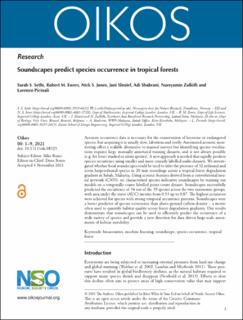| dc.contributor.author | Sethi, Sarab Singh | |
| dc.contributor.author | Ewers, Robert M. | |
| dc.contributor.author | Jones, Nick S. | |
| dc.contributor.author | Sleutel, Jani | |
| dc.contributor.author | Shabrani, Adi | |
| dc.contributor.author | Zulkifli, Nursyamin | |
| dc.contributor.author | Picinali, Lorenzo | |
| dc.coverage.spatial | Sabah, Malaysia | en_US |
| dc.date.accessioned | 2022-03-25T11:58:21Z | |
| dc.date.available | 2022-03-25T11:58:21Z | |
| dc.date.created | 2021-12-10T11:59:23Z | |
| dc.date.issued | 2021 | |
| dc.identifier.issn | 0030-1299 | |
| dc.identifier.uri | https://hdl.handle.net/11250/2987632 | |
| dc.description.abstract | Accurate occurrence data is necessary for the conservation of keystone or endangered species, but acquiring it is usually slow, laborious and costly. Automated acoustic monitoring offers a scalable alternative to manual surveys but identifying species vocalisations requires large manually annotated training datasets, and is not always possible (e.g. for lesser studied or silent species). A new approach is needed that rapidly predicts species occurrence using smaller and more coarsely labelled audio datasets. We investigated whether local soundscapes could be used to infer the presence of 32 avifaunal and seven herpetofaunal species in 20 min recordings across a tropical forest degradation gradient in Sabah, Malaysia. Using acoustic features derived from a convolutional neural network (CNN), we characterised species indicative soundscapes by training our models on a temporally coarse labelled point-count dataset. Soundscapes successfully predicted the occurrence of 34 out of the 39 species across the two taxonomic groups, with area under the curve (AUC) metrics from 0.53 up to 0.87. The highest accuracies were achieved for species with strong temporal occurrence patterns. Soundscapes were a better predictor of species occurrence than above-ground carbon density – a metric often used to quantify habitat quality across forest degradation gradients. Our results demonstrate that soundscapes can be used to efficiently predict the occurrence of a wide variety of species and provide a new direction for data driven large-scale assessments of habitat suitability. bioacoustics, machine learning, soundscape, species occurrence, tropical forest | en_US |
| dc.language.iso | eng | en_US |
| dc.rights | Navngivelse 4.0 Internasjonal | * |
| dc.rights.uri | http://creativecommons.org/licenses/by/4.0/deed.no | * |
| dc.subject | bioacoustics | en_US |
| dc.subject | machine learning | en_US |
| dc.subject | soundscape | en_US |
| dc.subject | species occurrence | en_US |
| dc.subject | tropical forest | en_US |
| dc.title | Soundscapes predict species occurrence in tropical forests | en_US |
| dc.type | Peer reviewed | en_US |
| dc.type | Journal article | en_US |
| dc.description.version | publishedVersion | en_US |
| dc.rights.holder | © 2021 The Authors | en_US |
| dc.subject.nsi | VDP::Økologi: 488 | en_US |
| dc.subject.nsi | VDP::Ecology: 488 | en_US |
| dc.source.journal | Oikos | en_US |
| dc.identifier.doi | 10.1111/oik.08525 | |
| dc.identifier.cristin | 1967035 | |
| dc.relation.project | Andre: NERC | en_US |
| dc.relation.project | Andre: WWF (Biome Health Project) | en_US |
| dc.relation.project | Andre: Sime Darby Foundation (SAFE Project) | en_US |
| dc.relation.project | Andre: EPSRC (EP/R511547/1 | en_US |
| dc.source.articlenumber | e08525 | en_US |
| cristin.ispublished | true | |
| cristin.fulltext | original | |
| cristin.qualitycode | 2 | |

